Ruibing Hou
un$^2$CLIP: Improving CLIP's Visual Detail Capturing Ability via Inverting unCLIP
May 30, 2025Abstract:Contrastive Language-Image Pre-training (CLIP) has become a foundation model and has been applied to various vision and multimodal tasks. However, recent works indicate that CLIP falls short in distinguishing detailed differences in images and shows suboptimal performance on dense-prediction and vision-centric multimodal tasks. Therefore, this work focuses on improving existing CLIP models, aiming to capture as many visual details in images as possible. We find that a specific type of generative models, unCLIP, provides a suitable framework for achieving our goal. Specifically, unCLIP trains an image generator conditioned on the CLIP image embedding. In other words, it inverts the CLIP image encoder. Compared to discriminative models like CLIP, generative models are better at capturing image details because they are trained to learn the data distribution of images. Additionally, the conditional input space of unCLIP aligns with CLIP's original image-text embedding space. Therefore, we propose to invert unCLIP (dubbed un$^2$CLIP) to improve the CLIP model. In this way, the improved image encoder can gain unCLIP's visual detail capturing ability while preserving its alignment with the original text encoder simultaneously. We evaluate our improved CLIP across various tasks to which CLIP has been applied, including the challenging MMVP-VLM benchmark, the dense-prediction open-vocabulary segmentation task, and multimodal large language model tasks. Experiments show that un$^2$CLIP significantly improves the original CLIP and previous CLIP improvement methods. Code and models will be available at https://github.com/LiYinqi/un2CLIP.
DIVE: Inverting Conditional Diffusion Models for Discriminative Tasks
Apr 24, 2025Abstract:Diffusion models have shown remarkable progress in various generative tasks such as image and video generation. This paper studies the problem of leveraging pretrained diffusion models for performing discriminative tasks. Specifically, we extend the discriminative capability of pretrained frozen generative diffusion models from the classification task to the more complex object detection task, by "inverting" a pretrained layout-to-image diffusion model. To this end, a gradient-based discrete optimization approach for replacing the heavy prediction enumeration process, and a prior distribution model for making more accurate use of the Bayes' rule, are proposed respectively. Empirical results show that this method is on par with basic discriminative object detection baselines on COCO dataset. In addition, our method can greatly speed up the previous diffusion-based method for classification without sacrificing accuracy. Code and models are available at https://github.com/LiYinqi/DIVE .
HIS-GPT: Towards 3D Human-In-Scene Multimodal Understanding
Mar 17, 2025Abstract:We propose a new task to benchmark human-in-scene understanding for embodied agents: Human-In-Scene Question Answering (HIS-QA). Given a human motion within a 3D scene, HIS-QA requires the agent to comprehend human states and behaviors, reason about its surrounding environment, and answer human-related questions within the scene. To support this new task, we present HIS-Bench, a multimodal benchmark that systematically evaluates HIS understanding across a broad spectrum, from basic perception to commonsense reasoning and planning. Our evaluation of various vision-language models on HIS-Bench reveals significant limitations in their ability to handle HIS-QA tasks. To this end, we propose HIS-GPT, the first foundation model for HIS understanding. HIS-GPT integrates 3D scene context and human motion dynamics into large language models while incorporating specialized mechanisms to capture human-scene interactions. Extensive experiments demonstrate that HIS-GPT sets a new state-of-the-art on HIS-QA tasks. We hope this work inspires future research on human behavior analysis in 3D scenes, advancing embodied AI and world models.
MATS: An Audio Language Model under Text-only Supervision
Feb 20, 2025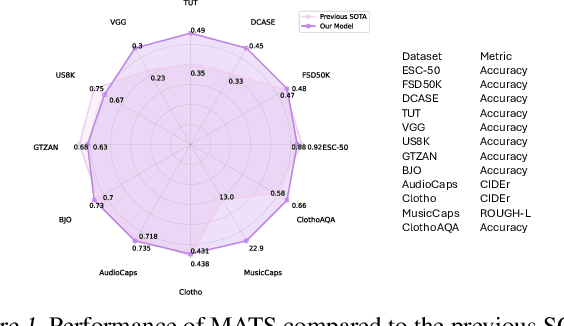
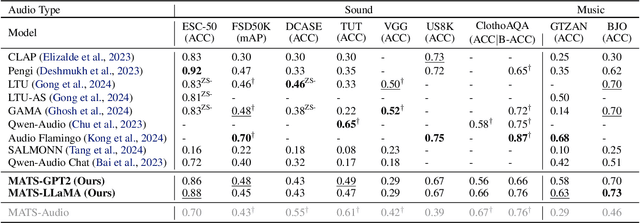
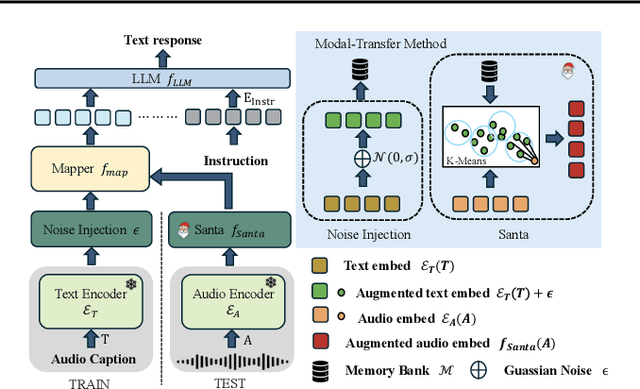
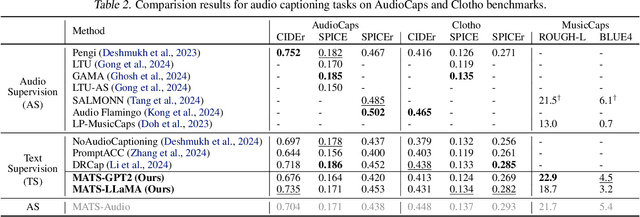
Abstract:Large audio-language models (LALMs), built upon powerful Large Language Models (LLMs), have exhibited remarkable audio comprehension and reasoning capabilities. However, the training of LALMs demands a large corpus of audio-language pairs, which requires substantial costs in both data collection and training resources. In this paper, we propose MATS, an audio-language multimodal LLM designed to handle Multiple Audio task using solely Text-only Supervision. By leveraging pre-trained audio-language alignment models such as CLAP, we develop a text-only training strategy that projects the shared audio-language latent space into LLM latent space, endowing the LLM with audio comprehension capabilities without relying on audio data during training. To further bridge the modality gap between audio and language embeddings within CLAP, we propose the Strongly-related noisy text with audio (Santa) mechanism. Santa maps audio embeddings into CLAP language embedding space while preserving essential information from the audio input. Extensive experiments demonstrate that MATS, despite being trained exclusively on text data, achieves competitive performance compared to recent LALMs trained on large-scale audio-language pairs.
RefHCM: A Unified Model for Referring Perceptions in Human-Centric Scenarios
Dec 19, 2024



Abstract:Human-centric perceptions play a crucial role in real-world applications. While recent human-centric works have achieved impressive progress, these efforts are often constrained to the visual domain and lack interaction with human instructions, limiting their applicability in broader scenarios such as chatbots and sports analysis. This paper introduces Referring Human Perceptions, where a referring prompt specifies the person of interest in an image. To tackle the new task, we propose RefHCM (Referring Human-Centric Model), a unified framework to integrate a wide range of human-centric referring tasks. Specifically, RefHCM employs sequence mergers to convert raw multimodal data -- including images, text, coordinates, and parsing maps -- into semantic tokens. This standardized representation enables RefHCM to reformulate diverse human-centric referring tasks into a sequence-to-sequence paradigm, solved using a plain encoder-decoder transformer architecture. Benefiting from a unified learning strategy, RefHCM effectively facilitates knowledge transfer across tasks and exhibits unforeseen capabilities in handling complex reasoning. This work represents the first attempt to address referring human perceptions with a general-purpose framework, while simultaneously establishing a corresponding benchmark that sets new standards for the field. Extensive experiments showcase RefHCM's competitive and even superior performance across multiple human-centric referring tasks. The code and data are publicly at https://github.com/JJJYmmm/RefHCM.
UniPose: A Unified Multimodal Framework for Human Pose Comprehension, Generation and Editing
Nov 25, 2024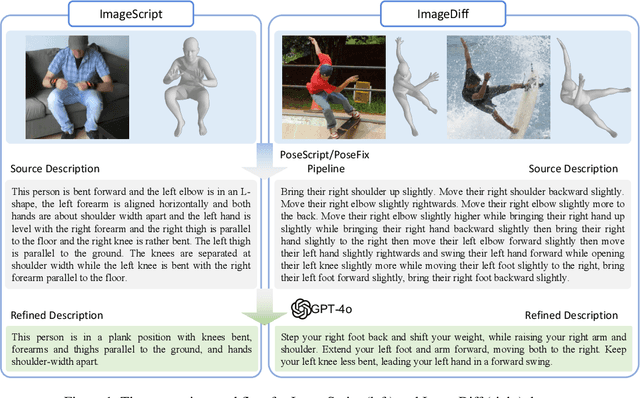
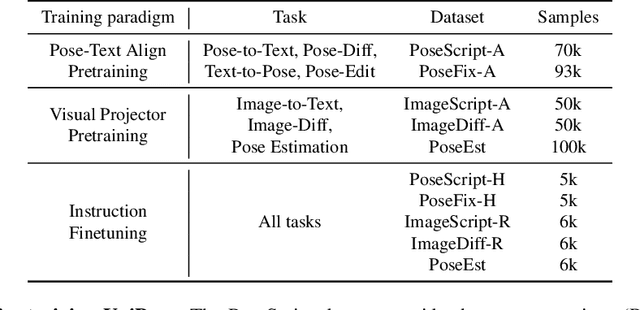
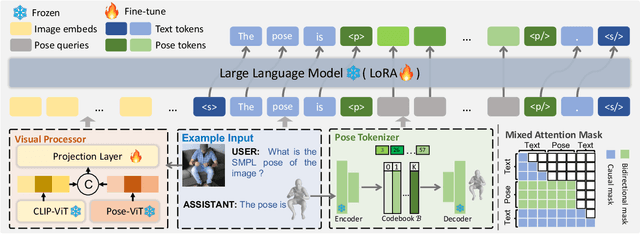
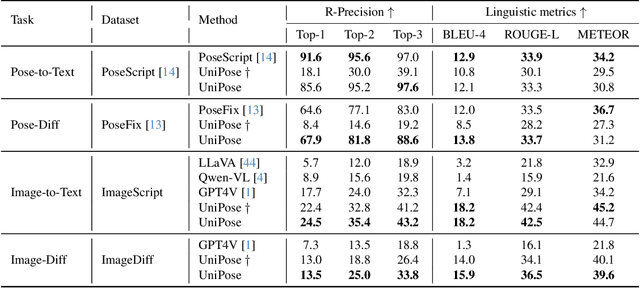
Abstract:Human pose plays a crucial role in the digital age. While recent works have achieved impressive progress in understanding and generating human poses, they often support only a single modality of control signals and operate in isolation, limiting their application in real-world scenarios. This paper presents UniPose, a framework employing Large Language Models (LLMs) to comprehend, generate, and edit human poses across various modalities, including images, text, and 3D SMPL poses. Specifically, we apply a pose tokenizer to convert 3D poses into discrete pose tokens, enabling seamless integration into the LLM within a unified vocabulary. To further enhance the fine-grained pose perception capabilities, we facilitate UniPose with a mixture of visual encoders, among them a pose-specific visual encoder. Benefiting from a unified learning strategy, UniPose effectively transfers knowledge across different pose-relevant tasks, adapts to unseen tasks, and exhibits extended capabilities. This work serves as the first attempt at building a general-purpose framework for pose comprehension, generation, and editing. Extensive experiments highlight UniPose's competitive and even superior performance across various pose-relevant tasks.
Morph: A Motion-free Physics Optimization Framework for Human Motion Generation
Nov 22, 2024Abstract:Human motion generation plays a vital role in applications such as digital humans and humanoid robot control. However, most existing approaches disregard physics constraints, leading to the frequent production of physically implausible motions with pronounced artifacts such as floating and foot sliding. In this paper, we propose \textbf{Morph}, a \textbf{Mo}tion-f\textbf{r}ee \textbf{ph}ysics optimization framework, comprising a Motion Generator and a Motion Physics Refinement module, for enhancing physical plausibility without relying on costly real-world motion data. Specifically, the Motion Generator is responsible for providing large-scale synthetic motion data, while the Motion Physics Refinement Module utilizes these synthetic data to train a motion imitator within a physics simulator, enforcing physical constraints to project the noisy motions into a physically-plausible space. These physically refined motions, in turn, are used to fine-tune the Motion Generator, further enhancing its capability. Experiments on both text-to-motion and music-to-dance generation tasks demonstrate that our framework achieves state-of-the-art motion generation quality while improving physical plausibility drastically.
UMFC: Unsupervised Multi-Domain Feature Calibration for Vision-Language Models
Nov 11, 2024



Abstract:Pre-trained vision-language models (e.g., CLIP) have shown powerful zero-shot transfer capabilities. But they still struggle with domain shifts and typically require labeled data to adapt to downstream tasks, which could be costly. In this work, we aim to leverage unlabeled data that naturally spans multiple domains to enhance the transferability of vision-language models. Under this unsupervised multi-domain setting, we have identified inherent model bias within CLIP, notably in its visual and text encoders. Specifically, we observe that CLIP's visual encoder tends to prioritize encoding domain over discriminative category information, meanwhile its text encoder exhibits a preference for domain-relevant classes. To mitigate this model bias, we propose a training-free and label-free feature calibration method, Unsupervised Multi-domain Feature Calibration (UMFC). UMFC estimates image-level biases from domain-specific features and text-level biases from the direction of domain transition. These biases are subsequently subtracted from original image and text features separately, to render them domain-invariant. We evaluate our method on multiple settings including transductive learning and test-time adaptation. Extensive experiments show that our method outperforms CLIP and performs on par with the state-of-the-arts that need additional annotations or optimization. Our code is available at https://github.com/GIT-LJc/UMFC.
HERM: Benchmarking and Enhancing Multimodal LLMs for Human-Centric Understanding
Oct 09, 2024Abstract:The significant advancements in visual understanding and instruction following from Multimodal Large Language Models (MLLMs) have opened up more possibilities for broader applications in diverse and universal human-centric scenarios. However, existing image-text data may not support the precise modality alignment and integration of multi-grained information, which is crucial for human-centric visual understanding. In this paper, we introduce HERM-Bench, a benchmark for evaluating the human-centric understanding capabilities of MLLMs. Our work reveals the limitations of existing MLLMs in understanding complex human-centric scenarios. To address these challenges, we present HERM-100K, a comprehensive dataset with multi-level human-centric annotations, aimed at enhancing MLLMs' training. Furthermore, we develop HERM-7B, a MLLM that leverages enhanced training data from HERM-100K. Evaluations on HERM-Bench demonstrate that HERM-7B significantly outperforms existing MLLMs across various human-centric dimensions, reflecting the current inadequacy of data annotations used in MLLM training for human-centric visual understanding. This research emphasizes the importance of specialized datasets and benchmarks in advancing the MLLMs' capabilities for human-centric understanding.
Generalized Semi-Supervised Learning via Self-Supervised Feature Adaptation
May 31, 2024
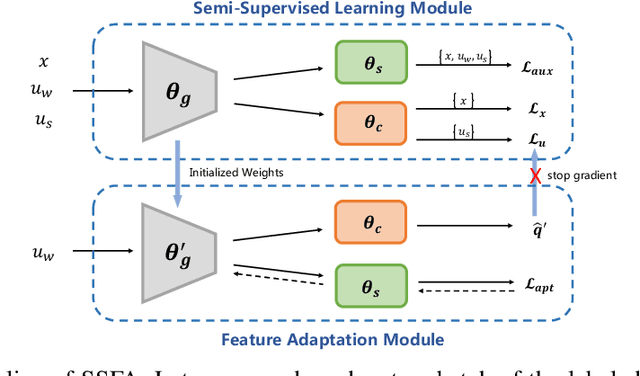


Abstract:Traditional semi-supervised learning (SSL) assumes that the feature distributions of labeled and unlabeled data are consistent which rarely holds in realistic scenarios. In this paper, we propose a novel SSL setting, where unlabeled samples are drawn from a mixed distribution that deviates from the feature distribution of labeled samples. Under this setting, previous SSL methods tend to predict wrong pseudo-labels with the model fitted on labeled data, resulting in noise accumulation. To tackle this issue, we propose Self-Supervised Feature Adaptation (SSFA), a generic framework for improving SSL performance when labeled and unlabeled data come from different distributions. SSFA decouples the prediction of pseudo-labels from the current model to improve the quality of pseudo-labels. Particularly, SSFA incorporates a self-supervised task into the SSL framework and uses it to adapt the feature extractor of the model to the unlabeled data. In this way, the extracted features better fit the distribution of unlabeled data, thereby generating high-quality pseudo-labels. Extensive experiments show that our proposed SSFA is applicable to various pseudo-label-based SSL learners and significantly improves performance in labeled, unlabeled, and even unseen distributions.
 Add to Chrome
Add to Chrome Add to Firefox
Add to Firefox Add to Edge
Add to Edge